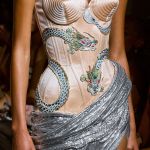
What happens to a dress after the Oscars?
The complete process of a garment, from catwalk to archive
March 28th, 2022
The Academy Awards are Haute Couture's most important event, perhaps more so than the fashion weeks through which the clothes are presented. As with the Met Gala, during the most anticipated red carpet of the year, the gowns receive the same detailed inspection as the films in competition, photographed, voted on and judged for days afterwards in the world's media. But between the kilometre-long train and eccentric details, what happens to the haute couture gowns once they are worn to the social events? We're unlikely to find Grimes in steel armour and a MISCHEF sword shopping in Los Angeles, and Jada Pinkett Smith is unlikely to want to put her bulky Glenn Martens Couture back on after commenting on camera that it was a 'physical effort' to wear it, yet it would be a waste to keep a $10,000 dress in the wardrobe. So what is the fate of couture dresses off the catwalk? A process full of interruptions, accidents, changes of program dictated by contingencies, which varies greatly depending on the company, given that the larger ones have the means to replicate the sample collection, allocating one to sales and another to the press or relocating them to different geographical areas, while the smaller companies have to be content with a single collection and hope that it doesn't get lost during a DHL shipment.
On the buyers' scrutiny: the sales campaign
The first step in the long pilgrimage that sample dresses undergo is the sales campaign, which lasts about three weeks. As soon as they come off the catwalk, the clothes are packed up and taken to a commercial showroom set up for buyers. Most buyers, especially Asian and American buyers, usually skip the Milan shows and only go to Paris, so for some brands it is necessary to set up a showroom in Italy, then France and then back to Milan for all possible buyers to see the samples. In the end, only the garments that have exceeded the minimum order threshold are sent into production. Not all the clothes from the fashion shows are destined for sale, but only about 30% of those shown on the catwalk, while the others, particularly spectacular, are designed only for the catwalks and will later become archive pieces for the maison. This is the case of Jean Paul Gaultier, Mugler, Galliano, Schiaparelli, of those designers who over the years have developed such spectacular dresses that they have been chosen cyclically by celebrities over the years, as was the case with the Butterfly Dress by Thierry Mugler, designed by Jerry Hall in 1997, and taken up over the decades by Jennifer Lopez in 1998, Beyoncé in 2008, Irina Shayk in 2021.
A question of marketing: between celebrities and influencers
After buyers, it's the turn of celebrities and influencers. The press office of the fashion company and the PRs of the media agencies are responsible for managing the hectic movement of clothes for magazines and talent from one continent to another. Not only do they decide who to lend the clothes to and what priority to give them to, they also have to know where they are going at all times, as they are responsible, along with the stylists, for any damage. Sometimes the press offices receive requests for a specific look, sometimes they are sent a list of several outfits to choose from according to availability, then the details of the photo shoot are provided: the day it will be taken, who the photographer will be, the stylist, the models and the address to which the outfits should be sent. Added to this intricate management of press shipments is the issue of celebrities and influencers. Some celebrities are given the honor of wearing clothes before they go into production, such as actress Ariana DeBose, who wore a Moschino dress worn by Bella Hadid a few days earlier in Milan to the Costume Designers Guild Awards. Influencers, on the other hand, are loaned the garments months later, in the season they are destined for, at the same time as the release of the collections in the shops, in a marketing campaign with posts to entice users to buy more sporty, everyday and low-end clothes than those of the red carpets because they are more accessible to buyers. The life cycle of the sample collection is therefore extremely long: it is divided into the long season, when magazines shoot the autumn-winter shoots, and the short season, spring-summer, when influencers wear and post the clothes on social networks.
When a dress becomes archive
Many months after the fashion show, almost all the clothes are returned to their original location. From here, some end up in internal sales for employees, journalists and industry insiders, others end up in outlets, the big brands generally store their samples in the warehouse or archive and from here some garments are borrowed for films or art projects, as in the case of the film Spencer, where costume designer Jacqueline Durran drew from Chanel catalogues to replicate Lady D's iconic outfits. The archives are also the main source for exhibitions of top designers, from the Musée Yves Saint Laurent Paris which houses the permanent exhibition of the designer of the same name, to the temporary exhibition dedicated to Thierry Mugler at the Museum of Decorative Arts. This is the process by which, with a bit of luck, a dress from the catwalks goes down in history.




























































